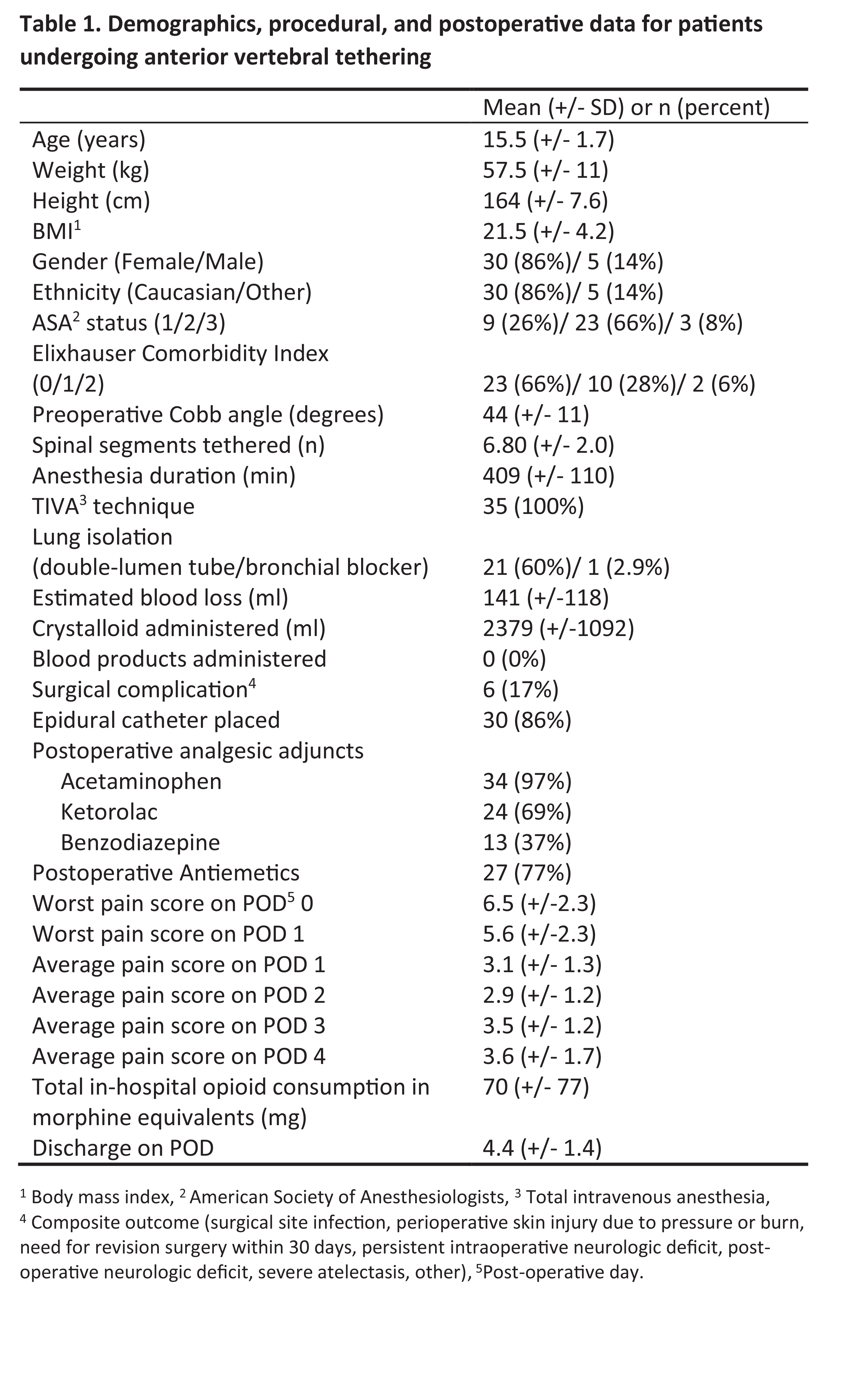GA1-45
Anesthetic Management and Postoperative Narcotic Consumption after a Novel, Fusion-less Adolescent Scoliosis Surgery
1Chen E, 2Rubenberg L, 2Meador G, 2Schroeck H
1Geisel School of Medicine at Dartmouth, Lebanon, NH, United states; 2Dartmouth-Hitchcock Medical Center, Lebanon, NH, United states
Introduction: Scoliosis surgery in adolescents is a major surgery with significant postoperative pain and a protracted recovery course (1,2). Anterior vertebral tethering (AVT) is a novel, fusion-less surgical approach that utilizes small incisions, endoscopy, and a synthetic “ligament†that serves as a potential alternative to traditional posterior spinal fusion (3, 4). This study aims to characterize the anesthetic and postoperative pain management after AVT at our institution.
Methods: All primary AVT procedures performed in patients 10-21 years of age between January 2014 and August 2017 were identified in the electronic medical record. The authors extracted patient characteristics and perioperative data pertaining to anesthetic and pain management. Postoperative pain was rated using a visual analogue pain scale or FLACC scale where appropriate. Descriptive statistics were generated using STATA statistical software.
Results: A total of 35 AVT cases performed by a single surgeon met inclusion criteria. Patient characteristics, procedural and postoperative details are summarized in Table 1. Most patients (n=30, 86%) underwent preoperative fluoroscopy-guided epidural placement. All patients received total intravenous anesthesia. No blood transfusions were necessary. The highest recorded postoperative pain score on post-operative day (POD) 0 was 6.5 (SD 2.3), and 5.6 (SD 2.3) on POD 1. Total in-hospital opioid consumption in morphine equivalents, excluding epidurally administered opioids, was 70 (SD 77) mg. Additional postoperative adjuncts included oral acetaminophen (n=34, 97%), ketorolac (n=24, 69%), and benzodiazepines (n=13, 37%). Antiemetics were required for 27 patients (77%). Epidural catheters were discontinued on POD 2.9 (SD 1), and patients were discharged home on POD 4.4 (SD 1.4).
Discussion: This study describes the perioperative management and postoperative pain control of 35 adolescents with adolescent scoliosis who underwent a novel surgical procedure for correction. Postoperative pain management was accomplished with a combination of neuraxial analgesia and non-opioid adjuncts. The data presented indicate adequate pain control and a short in-hospital recovery period, which compares favorably to outcomes after traditional fusion with typical discharge on later postoperative days and use of more narcotics (1,5).
Conclusion: As one of the first studies examining pain outcomes after this novel, fusion-less scoliosis surgery, the data presented can help inform spine surgeons and their patients about the expected shorter recovery period and decreased postoperative narcotic requirement associated with AVT while serving as a baseline for future adjustments to perioperative care.
References:
1. Spine 2013; 38: 1626-1631.
2. J Pediatr Orthop 2017; doi: 10.1097/BPO.0000000000000947. [Epub ahead of print]
3. Eur Spine J. 2015; ;24:1533-9..
4. Spine 2006; 31: 1314-1320.
5. J Pediatric Orthop 2012; 32: 799-804.
Top












